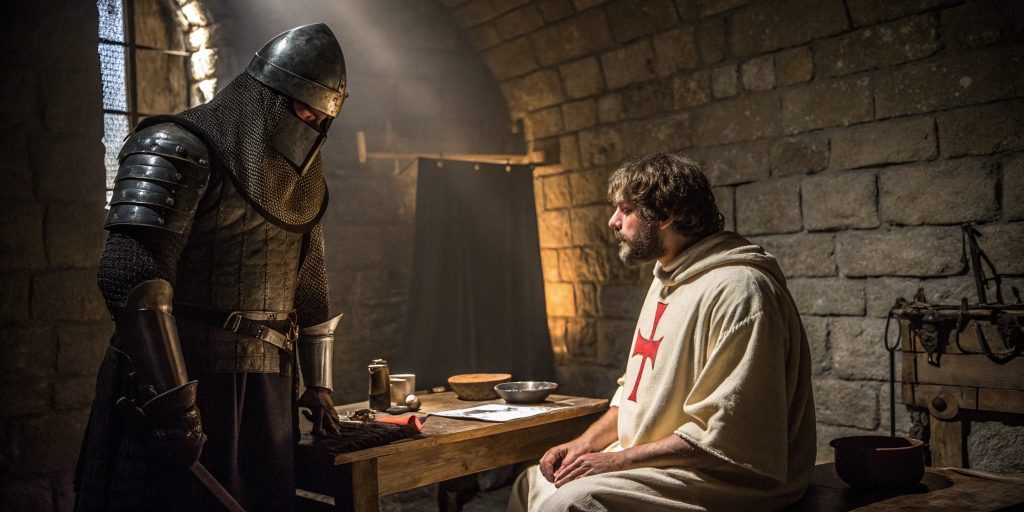In medieval Europe, diseases were a big problem, contributing to high mortality rates. They threatened health and tested medical skills. Templar medicine was key in medieval care. It showed how Knights Templar handled health issues for themselves and others.
They used unique healing methods to care for the sick and wounded during famine. They also faced many diseases, from infections to chronic problems.
Templar medicine’s history is fascinating. The Knights used medical texts and traditions to improve their care. This helps us understand a medieval diseases list and how medicine evolved to fight them.
The Historical Context of Templar Medicine
The Knights Templar began in the early 12th century. They mainly protected pilgrims going to the Holy Land, which was the start of their big role in healthcare.
As they grew stronger, they did more than fight diseases; they also contributed to developing early modern medical practices. They got involved in health and medicine, too. This was a big change for them.
The Knights Templar built hospitals all over Europe. These places were not just for the sick. They were where old healing ways met new medical knowledge from the Arab world.
This mix helped create a better way to deal with health problems. Back then, diseases were everywhere.
The Knights Templar’s work in healthcare was very important in addressing medieval health problems. They faced many health issues, like diseases and epidemics, and their work helped shape healthcare for the future.
Understanding Common Diseases in Medieval Europe
Disease was a big problem in medieval Europe. People didn’t know much about medicine, which led to many medieval illnesses spreading quickly.

Life was hard because of diseases of the middle ages. They changed how people saw health and disease.
Overview of Infectious Diseases
Diseases spread fast in those days. This caused a lot of mortality. Some big diseases were:
- The bubonic plague caused widespread fear and significant loss of life.
- Influenza, known for its seasonal outbreaks, was a major health problem of the Middle Ages.
- Smallpox and measles, which particularly affected vulnerable populations, were significant health problems during the early medieval period.
Bad sanitation and crowded living made things worse. People used herbal remedies and old knowledge to fight diseases.
Chronic Conditions Among the Population
Chronic diseases of the Middle Ages made life even harder. Tuberculosis and leprosy were common diseases, causing shame and isolation among medieval people.
Records show many babies died young, highlighting the issue of infant and child death during that time. They were very sick because of these diseases.
People didn’t know much about these diseases, and treatment was simple. Many used home remedies because doctors were rare.
The mix of infectious and chronic diseases made health bad in medieval Europe.
What Were Some Common Diseases in Medieval Europe
In the Middle Ages, many diseases spread through Europe. Both bacterial and viral infections caused a lot of sickness and death. Learning about these diseases helps us understand people’s health challenges back then.
Bacterial and Viral Infections
Bacterial infections were a big problem during this time. Leprosy not only harmed people’s bodies but also made them outcasts. Other deadly bacterial diseases were anthrax and the bubonic plague, causing many deaths and disrupting society.
Viral infections like smallpox and measles also killed many infants and contributed to mortality. They hurt both young children and adults. These illnesses showed how vulnerable people were to disease during the Middle Ages.
Endemic Diseases Impacting Health
Endemic diseases were always a threat in medieval communities. Malaria and dysentery were common in rural areas because of poor sanitation. These diseases weakened communities, making them more vulnerable to worse outbreaks and contributing to the greatest health problem of the later Middle Ages.
Knowing about these diseases helps us see the health challenges medieval societies faced. It also shows the health issues the Knights Templar dealt with in their duties.
Knights Templar and Health Practices
The Knights Templar had health practices based on their beliefs and the knowledge of their time. They used traditional healing and herbal remedies and kept their communities clean.

Traditional Healing Methods
The Knights Templar mixed practical medicine with old remedies. Healers used herbs and treatments passed down through generations. They treated sickness with bloodletting and poultices, combining science with superstition.
Role of Herbal Medicine
In medieval times, herbal medicine was key for the Knights Templar. They used plants for their healing powers. Willow bark helped with pain, and herbs like chamomile and sage fought infections.
Sanitation Practices Within Templar Communities
Cleanliness was vital in Templar communities. They maintained strict hygiene in hospitals and homes, which helped prevent diseases from spreading and reduced mortality rates. Keeping things clean was a big part of their health care to avoid fever and other medieval illnesses.
The Impact of Epidemics on Medieval Society
The Black Death lasted from 1347 to 1351 and greatly changed medieval society. It killed up to one-third of the people, causing major labor shortages. In response to the health problems of the Middle Ages, this changed how people worked and who was in charge.
Communities were filled with grief. This changed how people lived and interacted, especially during periods of high mortality. They had to deal with a new way of life.
Major Outbreaks: The Black Death and Beyond
The Black Death had big effects that lasted long after it ended. It made people change and find new ways to live, particularly in light of the health problems of the Middle Ages. Other outbreaks showed that people were still at risk.
Authorities tried to stop these diseases but faced big challenges. They realized they needed better ways to keep people healthy.
Responses to Disease Outbreaks
Medieval society tried many things to fight dark ages diseases, acknowledging the significant health problems of the Middle Ages. They used quarantine and built pest houses to keep sick people away from the healthy population during flu outbreaks. The Knights Templar helped by supporting the sick.
These efforts helped shape how we deal with health crises today. They also showed the importance of caring for each other during tough times, especially in the face of diseases in the Middle Ages.

